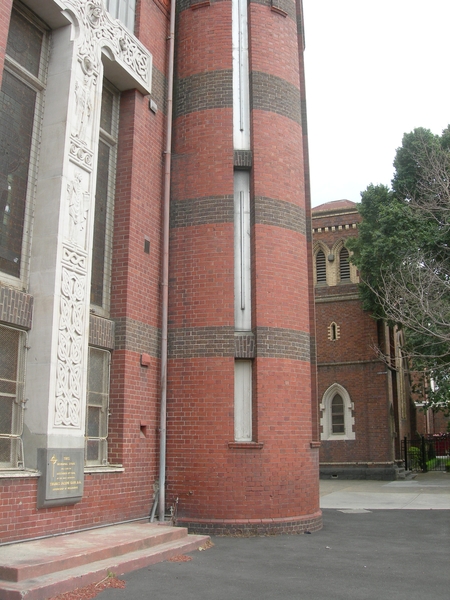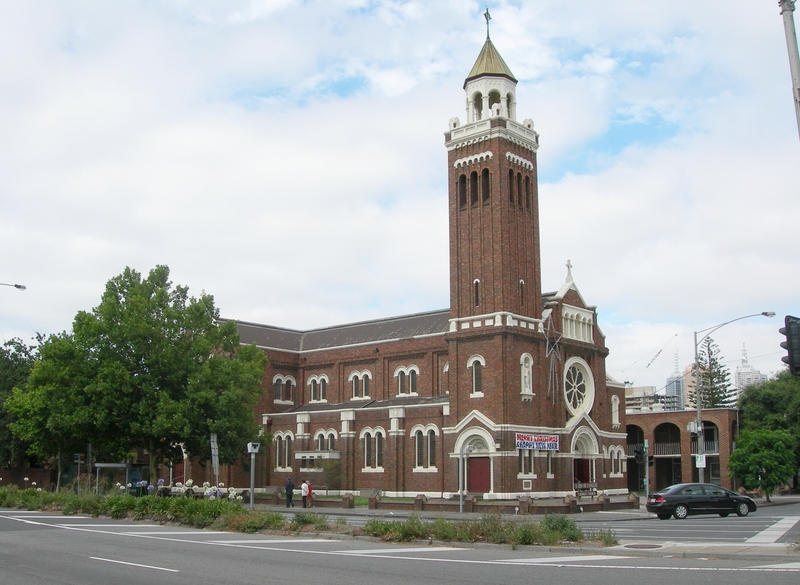ST JOHNS CHURCH
576-594 VICTORIA PARADE AND 1251-1289 HODDLE STREET AND 2-30 ALBERT STREET EAST MELBOURNE, MELBOURNE CITY
-
Add to tour
You must log in to do that.
-
Share
-
Shortlist place
You must log in to do that.
- Download report







Statement of Significance
'What is significant?
St John's Church, the second church within the St John's complex, was built in 1900 to the design of architects McCrae and O'Toole. It is an idiosyncratic interpretation of the Romanesque style, built in red brick. The main facade is asymmetrical and incorporates a 10 metre high Celtic cross, pressed terracotta panels in the gable with representation of the stars of the Southern Cross, and a 26 metre high round tower with conical roof. The cross is of Stawell stone and weighs 21 tons. It portrays the head of Christ at its centre, surrounded by the four evangelists in full-relief. Below are full-length bas-relief portraits of St John and St Patrick. The remainder of the cross is carved with Celtic runes. The designer of the cross is not known.
How is it significant?
St Johns Church is of architectural and historical significance to the State of Victoria.
Why is it significant?
St John's Church is architecturally significant as a highly unusual expression of the Romanesque style. The Arts and Crafts mode of design, as expressed at St John?s Church by the architects McCrae and O'Toole, is rare in churches in the State of Victoria. The use of pressed terracotta was unusual in church decoration at the turn of the 20th century and was more commonly favoured in secular buildings.
St John's Church is also the only known Victorian work of the architects McRae and O'Toole.
St John's Church is historically significant for its expression of Irish and Australian nationalist sentiment at the time of Federation, and as a distinctively Irish interpretation of the Romanesque style of the Roman Catholic Church. The round tower was claimed to be a replica of the entrance to King Cormac's Chapel built in 1137 on the rock of Cashel in Tipperary.
-
-
ST JOHNS CHURCH - History
Contextual History: The Catholic Church commenced activities on the site in 1865 when J B denny of St Patrick's Cathedral gave notice to the Melbourne City Council that a new chapel was to be built on the corner of Albert and Hoddle Streets. When the chapel became too small a second church was built in 1901, distinguished by a large Celtic Cross and round tower. The third church was built on the corner of Victoria Parade and and Hoddle Street in 1929-30 on land acquired from the Church of England in 1920. A school was included on the Albert Street frontage in 1889.ST JOHNS CHURCH - Permit Exemptions
General Exemptions:General exemptions apply to all places and objects included in the Victorian Heritage Register (VHR). General exemptions have been designed to allow everyday activities, maintenance and changes to your property, which don’t harm its cultural heritage significance, to proceed without the need to obtain approvals under the Heritage Act 2017.Places of worship: In some circumstances, you can alter a place of worship to accommodate religious practices without a permit, but you must notify the Executive Director of Heritage Victoria before you start the works or activities at least 20 business days before the works or activities are to commence.Subdivision/consolidation: Permit exemptions exist for some subdivisions and consolidations. If the subdivision or consolidation is in accordance with a planning permit granted under Part 4 of the Planning and Environment Act 1987 and the application for the planning permit was referred to the Executive Director of Heritage Victoria as a determining referral authority, a permit is not required.Specific exemptions may also apply to your registered place or object. If applicable, these are listed below. Specific exemptions are tailored to the conservation and management needs of an individual registered place or object and set out works and activities that are exempt from the requirements of a permit. Specific exemptions prevail if they conflict with general exemptions. Find out more about heritage permit exemptions here.
-
-
-
-
-
COLLINGWOOD TOWN HALL
 Victorian Heritage Register H0140
Victorian Heritage Register H0140 -
RESIDENCE
 Victorian Heritage Register H0142
Victorian Heritage Register H0142 -
RESIDENCE
 Victorian Heritage Register H0143
Victorian Heritage Register H0143
-
'Mororo' 13 Oxford Street, Malvern
 Stonnington City
Stonnington City -
1 Arnold Street
 Yarra City
Yarra City -
1 Austin Street
 Yarra City
Yarra City
-
-












